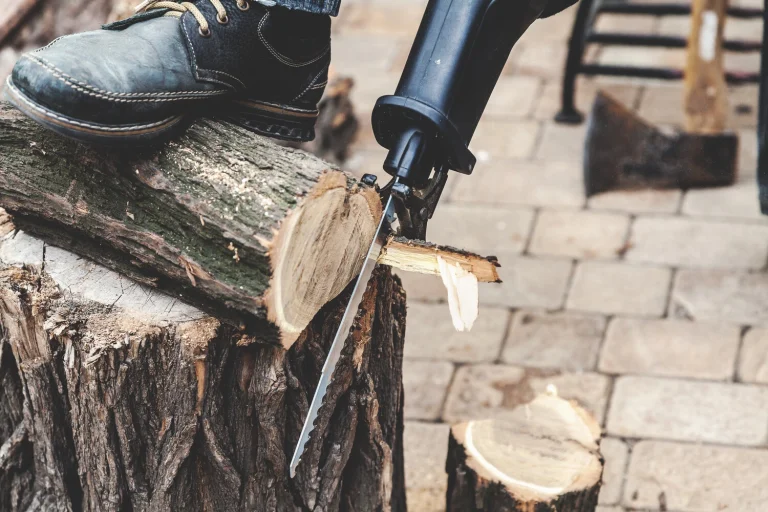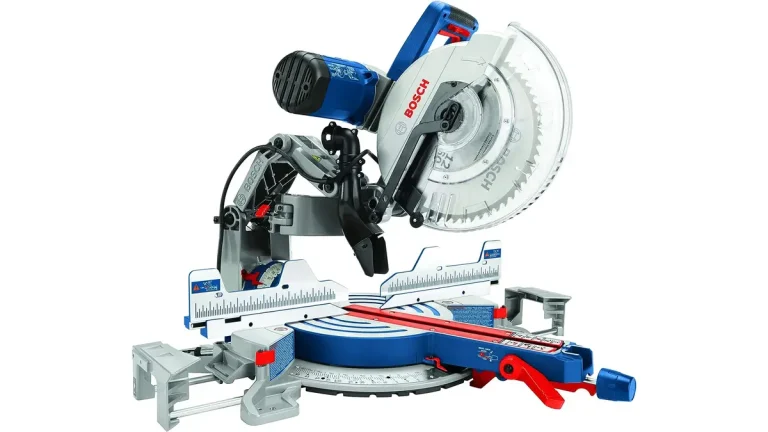Best Corded Reciprocating Saw to Cut It Out
Are you looking for a reciprocating saw that can make clean, accurate cuts every time?
Whether you’re a DIYer tackling weekend projects or a professional contractor cutting through tough materials, you need the right tools for the job.
That’s where the best reciprocating saw comes in!
With a powerful motor and robust build quality, it will help you cut through almost anything with precision and ease.
Read on to find out what makes this tool perfect for your next project and our picks for the best on the market!
How We Choose the Best Reciprocating Saws
There are a lot of reciprocating saws on the market.
How do you choose the best one for your needs?
It can be tough to figure it out.
With all of the options available, it’s hard to know where to start.
We’ve read through thousands of Amazon reviews and considered the specs and features of all of the major brands to narrow it down to these choices for the best reciprocating saws.
Whether you’re looking for a heavy-duty saw or something more lightweight and portable, we’ve got you covered.
Overall Winner – Best Reciprocating Saw
Makita 12 Amp Reciprocating Saw (JR3051T)
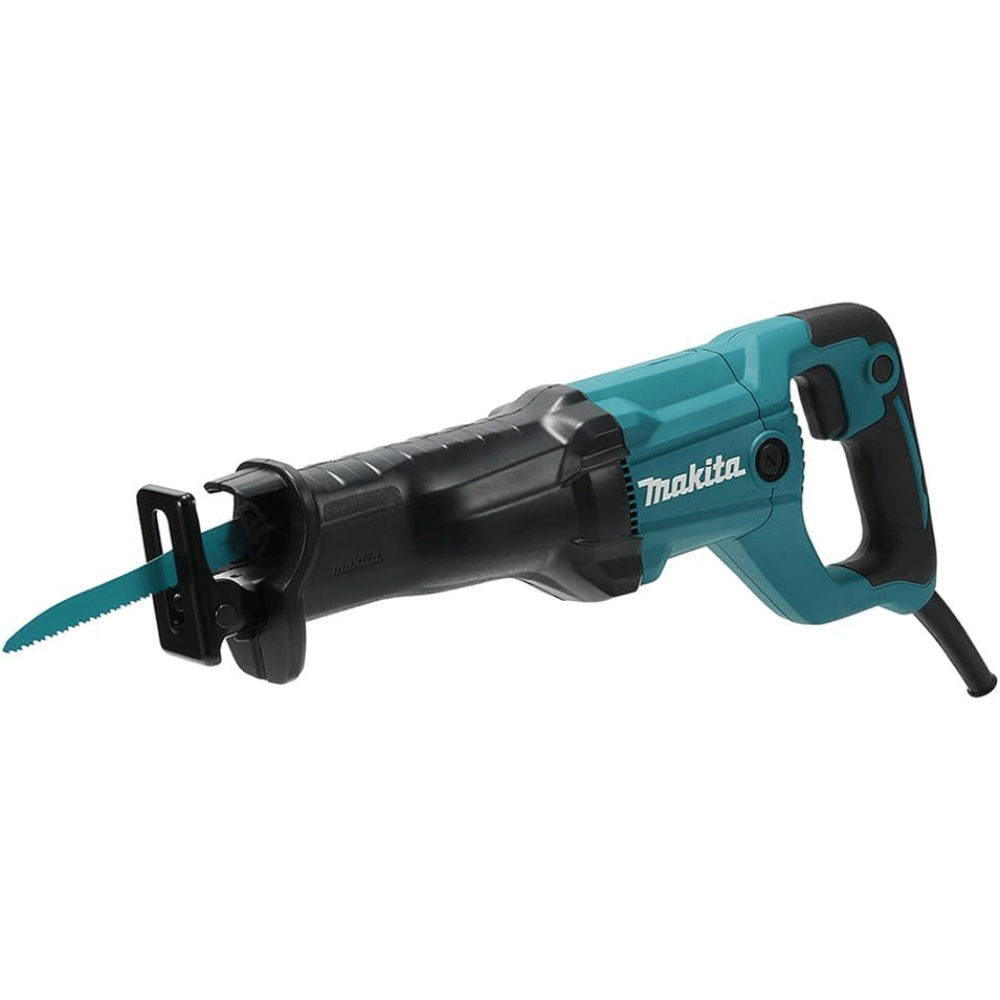
Key Features
- 12 amp motor provides 3,000 strokes per minute (SPM)
- 1-3/16″ stroke for fast cutting
- 17-5/8″ long and 7.3 lbs
Why It’s a Great Choice
Are you ready for a reciprocating saw that is a cut above the rest?
The Makita 12 Amp Reciprocating Saw (JR3051T) is the perfect addition to your toolkit.
This little wonder boasts superior power and performance with less vibration, making challenging projects easier than ever.
With its 12 AMP motor and electronic speed control, it can maintain constant speed under load, allowing you to get even the toughest cutting done quickly with maximum efficiency.
Furthermore, the JR3051T has a long 1-3/16” stroke and 0-3,000 SPM—taking your productivity and work quality through the roof!
And don’t worry about handheld fatigue -it weighs only 7.3 lbs. and is 17-5/8″ in length, giving you maximum comfort as you take your projects from mundane to magnificent!
But it gets better still: you won’t ever have to worry about dust or debris cutting your working life short with this Makita.
It has a durable body design and sealings that help keep dust and water out for an even longer tool life.
Plus, tool-less changing of your reciprocating saw blades makes swapping from project to project blissfully easy.
Get all this—and more—with the Makita 12 Amp Reciprocating Saw!
Make quick work of any project today – order yours now!
Most Versatile Reciprocating Saw
DEWALT 12 Amp Reciprocating Saw (DWE305)
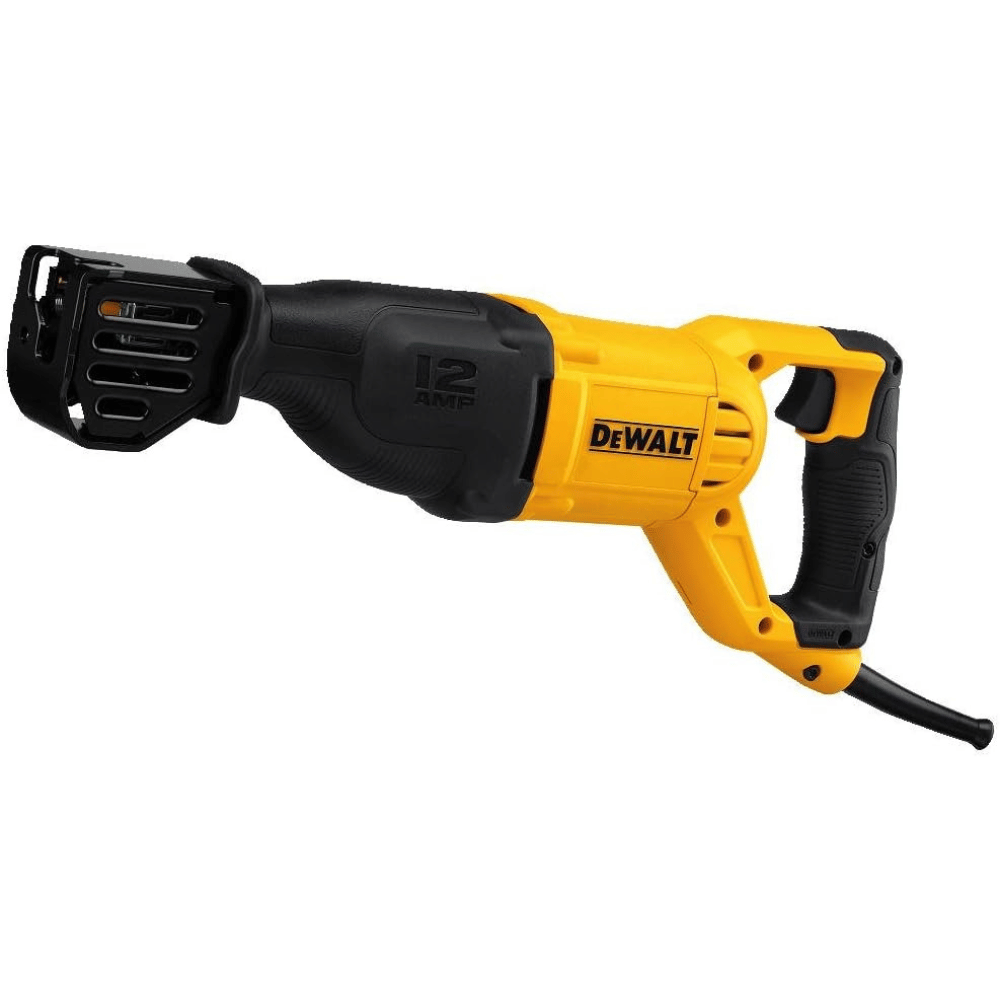
Key Features
- 12 amp motor provides up to 2,900 SPM
- 1-1/8″ stroke length
- 4-position blade clamp
Why It’s a Great Choice
The DEWALT 12 Amp Reciprocating Saw is a power tool that’s bringing DIYers and contractors closer to their projects with maximum convenience and accuracy.
This tool features a powerful 12 Amp motor, variable speed trigger, and a 1-1/8-inch stroke length for fast and reliable cutting.
A keyless, lever-action blade clamp enables you to complete blade changes in four directions quickly, making it perfect for even the most challenging applications like flush cutting.
If you thought you had to sacrifice convenience for performance with your reciprocating saws, think again!
The variable speed trigger on the DEWALT 12 Amp Reciprocating Saw allows you to instantly control speed from 0 to 2,900 SPM—saving you time and energy.
So what are you waiting for?
Get things done faster with this must-have saw that tackles a spectrum of DIY jobs without breaking a sweat!
Best Reciprocating Saw on a Budget
PORTER-CABLE 8 Amp Reciprocating Saw (PC85TRSOK)
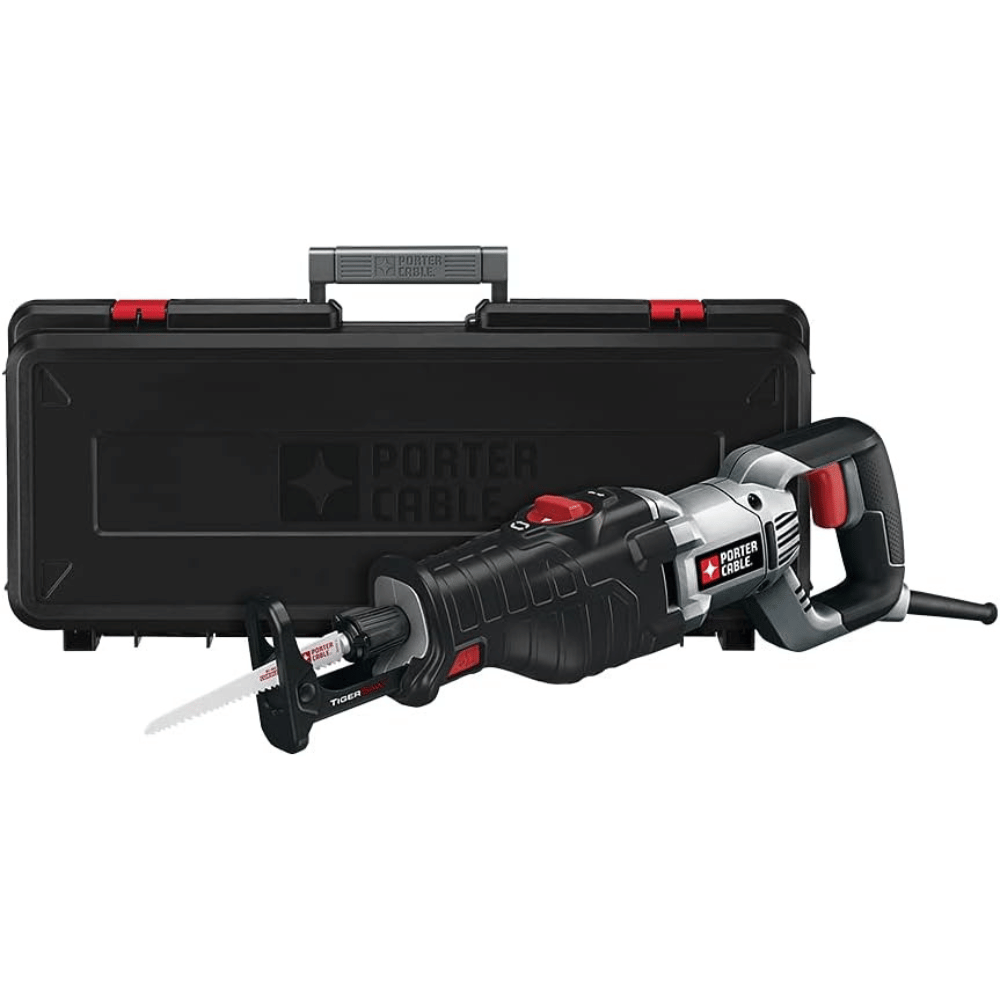
Key Features
- 8 amp motor provides up to 3,200 SPM
- 1-1/8″ stroke
- Orbital cutting action for aggressive cutting tasks
Why It’s a Great Choice
If you’re in the market for a powerful, reliable, and relentless saw, then PORTER-CABLE’s 8 Amp Reciprocating Saw is your go-to.
As part of the robust and compact design, this tool features an 8.5 AMP motor, along with a 1-1/8 inch stroke that can churn out nice and steady 3,200 strokes per minute.
To ensure quick cuts, this saw has an orbital selection dial that helps users get the job done faster when they aren’t worried about the quality of their final cut.
They also included some bonuses like a tool-free shoe adjustment and twist lock blade clamp system that makes it easy to change blades on the fly.
And if convenience wasn’t enough, they even added in an over-molded handle and clamshell boot for more control over your saw while making sure comfort doesn’t take a hit.
So whether you’re looking for precision or demolishing something quickly…this PORTER-CABLE reciprocating saw has you covered!
Best Low-Vibration Reciprocating Saw
SKIL 13 Amp Corded Reciprocating Saw with Buzzkill Technology (SPT44A-00)
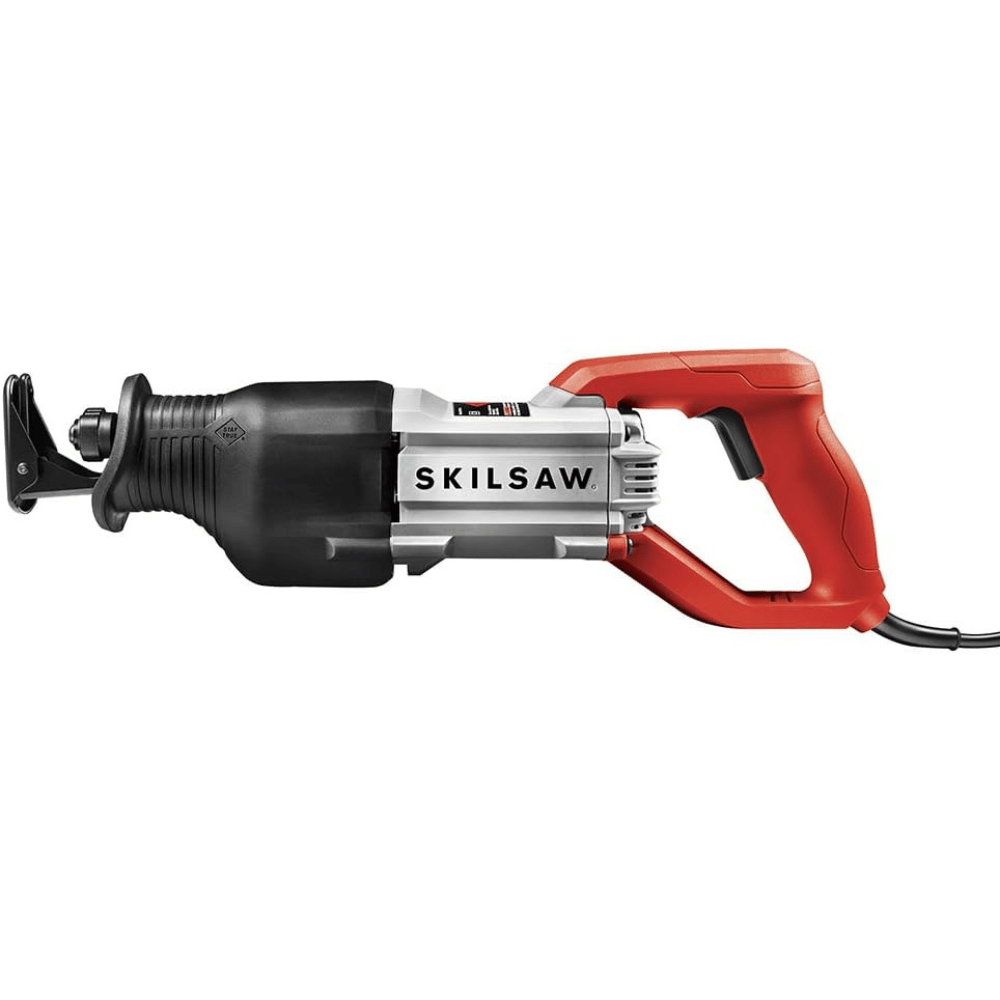
Key Features
- 13 Amp motor
- 1-1/8″ stroke length
- Buzzkill Technology for unmatched vibration suppression
Why It’s a Great Choice
Step up your DIY game with the SKIL 13 Amp Reciprocating Saw!
This saw was made for those DIYers and contractors with hands that don’t rest until the job gets done.
The saw’s patented Buzzkill Technology ensures vibration suppression to make sure you are in control during all your cutting tasks.
But this baby is more than just a smooth operator.
Its unique body design gives you confidence knowing it will help direct dust and debris away from you as you work.
Plus, its tool-less blade clamp gets a solid hold on even the toughest of job sites, while its oversized trigger gives you the flexibility to cut in multiple positions so your projects can look their very best.
We could keep going about this superstar saw, but the truth is, actions speak louder than words.
So let this SKIL saw do all the talking for you.
Best Compact Reciprocating Saw
DEWALT 12 Amp Compact Reciprocating Saw (DWE357)
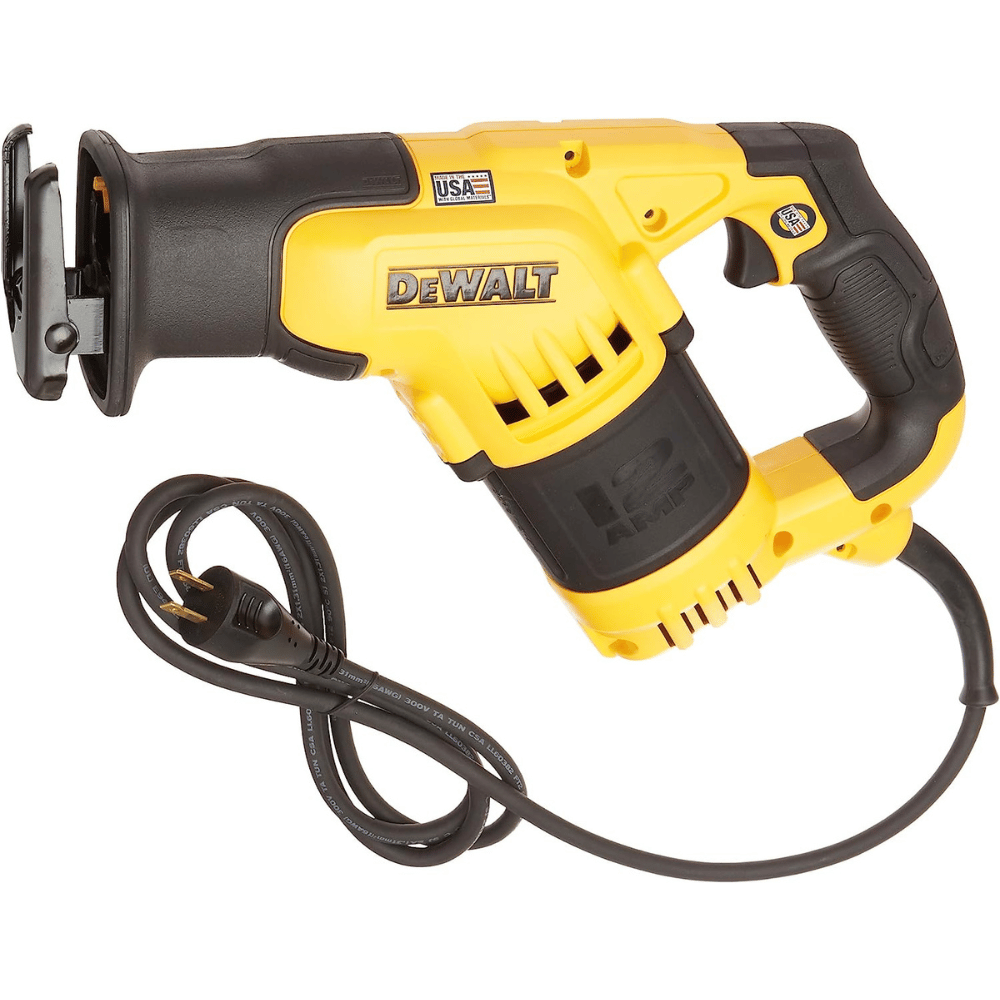
Key Features
- 12 amp motor provides up to 3,000 SPM
- 1-1/8″ stroke length
- 14.5″ total length
Why It’s a Great Choice
For DIYers and contractors alike, the DEWALT 12 Amp Compact Reciprocating Saw is just what your toolbox ordered!
The keyless blade clamp comes in clutch making fast and easy blade changes effortless – no levers or keys necessary.
Plus, its impressive power makes it able to tackle whatever you can throw at it.
This saw is designed to make clean cuts through any job, boasting a 0-3,000 SPM and a 1-1/8-inch stroke length that packs a punch.
And with its compact design and lightweight construction, fits perfectly between studs so you don’t have to worry about cutting in cramped quarters.
PLUS, the pivoting shoe provides leverage for different applications like delicate curves or vertical cuts – no sweat.
No matter how complicated your project might be, this little guy does the heavy-duty lifting for you.
It means business too – every element gives off major comfort vibes so you can work confidently instead of nervously waiting for cramps from uncomfortable handles – between its overmolded grip material AND variable speed trigger?
Who needs comfort food when they have the DEWALT 12 Amp Compact Recip?
Buyer’s Guide to the Best Corded Reciprocating Saws
Shopping for a reciprocating saw can be confusing because there are so many different features and options to choose from.
It’s hard to know which is the best for your needs because there are so many different brands and models on the market.
We’ve put together a list of the most commonly asked questions when shopping for a reciprocating saw, to help make your decision easier.
What is a reciprocating saw?
A reciprocating saw is a power tool that uses an electric motor to drive a blade back and forth in a rapid, reciprocating motion. It is designed to cut through a variety of materials such as wood, metal, plastic, and more. Some saws require a power cord to be plugged into an electrical outlet to function, unlike cordless saws which run on batteries. Corded saws are commonly used in construction, demolition, and remodeling projects, as well as for DIY tasks around the home.
How does a reciprocating saw work?
A reciprocating saw works by using a motor to drive a blade back and forth in a rapid, reciprocating motion. The blade is typically attached to a clamp that can be adjusted to various angles, allowing the user to cut through a variety of materials at different depths and angles.
When the trigger is pressed, the motor powers up and moves the blade forward, cutting through the material. As the blade reaches the end of its forward motion, it reverses direction and moves back, ready to make the next cut.
The blade of a reciprocating saw can be changed quickly and easily, allowing the user to switch between different types of blades depending on the material being cut. Reciprocating saws are versatile tools that can be used for a variety of cutting tasks, from cutting through thick branches to demolishing walls.
What are the benefits of using a corded reciprocating saw?
Here are some benefits of using a corded reciprocating saw:
- Power: Corded models are generally more powerful than their cordless counterparts because they are powered by an electric motor, which allows them to cut through tougher materials with ease.
- Constant Power: Since corded saws are connected to a power source, you don’t have to worry about the battery running out in the middle of a job. You can work continuously without interruption.
- Longer Operating Time: Unlike cordless reciprocating saws which need to be recharged, corded saws can operate for an extended period without any breaks.
- Cost: Corded models are generally less expensive than cordless reciprocating saws, making them a great option for those on a budget.
- Minimal Maintenance: Corded models require minimal maintenance since they don’t have a battery that needs to be charged or replaced. You only need to change the blade when it becomes dull.
- Versatility: Corded saws are versatile tools that can be used for a variety of cutting tasks, from cutting through thick branches to demolishing walls. They can also be used with different types of blades to cut through different materials.
Overall, a reciprocating saw is a reliable, powerful, and cost-effective tool that can handle a wide range of cutting tasks.
Should I get a corded or cordless reciprocating saw?
The decision to choose between a corded or cordless reciprocating saw ultimately depends on your personal preferences and specific needs. Here are some factors to consider that can help you decide:
Corded Reciprocating Saw:
- More power: Corded reciprocating saws are generally more powerful than cordless models due to being connected to an electrical outlet. This means they can handle tougher materials with ease.
- Continuous use: Since corded saws are plugged into an outlet, you don’t have to worry about running out of power or waiting for a battery to recharge.
- Cost-effective: Corded saws are typically less expensive than cordless models due to not having a battery included.
- More portable: Cordless saws are more portable and can be used anywhere without the need for an electrical outlet or extension cord.
- Convenience: Cordless saws are convenient since they don’t have a cord that can get in the way or tangle during use.
- Variety of applications: Cordless saws are ideal for cutting in tight spaces, such as between studs or in corners, due to their portability.
In summary, if you need a powerful saw for heavy-duty cutting tasks and don’t mind being tethered to an outlet, then a corded reciprocating saw might be the better option. However, if you need a more portable option for cutting in tight spaces or for quick, small jobs, then a cordless reciprocating saw might be the better choice.
What types of materials can a reciprocating saw cut?
A reciprocating saw can cut through a variety of materials, including:
- Wood: A reciprocating saw can be used to cut through both soft and hardwoods, such as lumber, branches, and tree limbs.
- Metal: Reciprocating saws can cut through metal, including steel pipes, copper tubing, and nails.
- Plastics: A reciprocating saw can be used to cut through various types of plastic, including PVC pipes and plastic sheets.
- Drywall: Reciprocating saws are great for cutting through drywall, especially for making openings for electrical boxes, plumbing, and windows.
- Masonry: Reciprocating saws equipped with special masonry blades can cut through brick, concrete, and stone.
- Fiberglass: Reciprocating saws can cut through fiberglass materials, including boat hulls, hot tubs, and shower stalls.
- Composite materials: Reciprocating saws can cut through composite materials, including countertops, decking, and flooring.
In summary, a reciprocating saw is a versatile tool that can cut through a wide range of materials, making it an essential tool for construction, remodeling, demolition, and DIY projects.
How do I choose a reciprocating saw blade?
Choosing the right reciprocating saw blade is important for achieving the best results in your cutting tasks. Here are some factors to consider when choosing a reciprocating saw blade:
- Material: The type of material you are cutting will determine the type of blade you need. For example, wood blades are designed to cut through wood, while metal blades are designed to cut through metal.
- Teeth per inch (TPI): The TPI of a blade refers to the number of teeth on the blade. Blades with a higher TPI are better suited for cutting through thin materials, while blades with a lower TPI are better suited for cutting through thicker materials.
- Blade length: Blade length is an important consideration, as it determines how deep the blade can cut. Longer blades are better for cutting through thicker materials, while shorter blades are better for cutting through thinner materials.
- Blade thickness: Blade thickness also affects cutting performance. Thicker blades are sturdier and can withstand more pressure, while thinner blades are more flexible and can make tighter turns.
- Blade material: The material of the blade affects its durability and cutting performance. High-speed steel (HSS) blades are suitable for cutting through wood and metal, while bi-metal blades are designed for tougher cutting tasks and can cut through a variety of materials. Carbide-tipped blades are the most durable and are best for cutting through hard materials like masonry and ceramic.
In summary, when choosing a reciprocating saw blade, consider the material you are cutting, the teeth per inch, blade length, blade thickness, and blade material. Make sure to select a blade that is compatible with your saw model and follow the manufacturer’s recommendations for safe and effective use.
How do I change the blade on my reciprocating saw?
Here are the general steps to change the blade on your reciprocating saw:
- Unplug the saw or remove the battery pack if it is a cordless model.
- Loosen the blade clamp by turning it counterclockwise. The blade clamp is usually located near the front of the saw.
- Remove the old blade by pulling it out of the blade clamp.
- Insert the new blade into the blade clamp with the teeth of the blade facing forward.
- Tighten the blade clamp by turning it clockwise until it is securely in place.
- Pull on the blade to ensure it is firmly seated in the blade clamp.
- Plug in the saw or reinsert the battery pack.
- Test the saw by turning it on and checking that the blade is moving smoothly.
Note: Always make sure to follow the manufacturer’s instructions when changing the blade on your reciprocating saw, as the process may vary slightly depending on the specific model. Also, be sure to wear safety goggles and gloves when working with the saw to protect yourself from flying debris.
Can I use a reciprocating saw for demolition work?
Yes, a reciprocating saw is an excellent tool for demolition work. Its powerful motor and blade action makes it ideal for cutting through a variety of materials, such as wood, metal, plaster, drywall, and more. The versatility of a reciprocating saw also makes it well-suited for demolition work, as it can make flush cuts and reach tight spaces that other tools can’t.
In addition to cutting through materials, a reciprocating saw can also be used to remove nails, screws, and other fasteners. By using the appropriate blade, you can quickly and easily disassemble walls, flooring, and other structures.
When using a reciprocating saw for demolition work, it’s important to wear appropriate safety gear, such as gloves, safety glasses, and hearing protection. Also, be sure to follow the manufacturer’s instructions for the safe and effective use of the tool.
How powerful should my reciprocating saw be?
The power of a reciprocating saw is typically measured in amps or volts, depending on whether it is corded or cordless. The power you need will depend on the type of work you plan to do with the saw.
For light-duty tasks, such as cutting through thin materials or occasional use around the house, a saw with 7-10 amps or 12-18 volts may be sufficient.
For heavier-duty tasks, such as demolition work or cutting through thicker materials, you may need a more powerful saw with 10-15 amps or 18-20 volts.
Keep in mind that a more powerful saw will typically be heavier and may be more difficult to control, especially for beginners. Therefore, it’s important to choose a saw with a power level that matches your skill level and the type of work you plan to do.
Additionally, other factors such as stroke length and orbital action can also affect the cutting performance of a reciprocating saw. Therefore, it’s important to consider these factors as well when choosing a saw that meets your needs.
What features should I look for in a reciprocating saw?
When choosing a reciprocating saw, there are several features to consider. Here are some of the most important features to look for:
- Variable speed: A saw with a variable speed trigger allows you to adjust the speed of the blade, giving you greater control over the cutting process.
- Orbital action: This feature allows the blade to move in a circular motion as well as back and forth, which can make cutting faster and more efficient.
- Adjustable shoe: An adjustable shoe allows you to adjust the depth of the cut and provides greater stability during use.
- Tool-less blade change: A tool-less blade change feature makes it quick and easy to change blades without requiring additional tools.
- Anti-vibration system: This feature reduces the amount of vibration produced by the saw, which can reduce user fatigue and make cutting more comfortable.
- Length of stroke: The length of the stroke determines how deep the saw can cut. Longer strokes are better for cutting through thicker materials, while shorter strokes are better for cutting through thinner materials.
- Amps or volts: The power of a reciprocating saw is typically measured in amps (for corded models) or volts (for cordless models). Choose a saw with the appropriate power for the type of work you plan to do.
- Weight and balance: The weight and balance of the saw can affect its ease of use and user comfort, especially during extended use.
Overall, when choosing a reciprocating saw, consider the features that are most important for the types of projects you will be working on, and choose a saw that meets your needs and preferences.
How do I maintain my reciprocating saw?
Proper maintenance of your reciprocating saw can help ensure its longevity and optimal performance. Here are some tips for maintaining your reciprocating saw:
- Clean the saw regularly: After each use, wipe down the saw with a clean, dry cloth to remove dust, debris, and any other residue that may have accumulated on the saw.
- Lubricate the blade: Apply a small amount of lubricating oil to the blade after each use to prevent rust and ensure smooth operation.
- Check the blade for damage: Inspect the blade for any signs of damage, such as cracks or missing teeth. Replace any damaged blades immediately.
- Check the cord: If you have a corded saw, check the cord for any signs of damage, such as cuts or fraying. If you notice any damage, replace the cord before using the saw.
- Store the saw properly: When not in use, store the saw in a clean, dry place, away from any moisture or extreme temperatures.
- Check and replace worn-out parts: Check the saw’s parts, such as the shoe or blade clamp, for any signs of wear or damage. Replace any worn-out parts as needed to maintain the saw’s optimal performance.
- Follow the manufacturer’s instructions: Follow the manufacturer’s instructions for maintenance and use of the saw to ensure safe and effective operation.
By following these tips, you can help ensure your reciprocating saw remains in good condition and performs at its best.
Can I use a reciprocating saw for pruning trees and bushes?
Yes, a reciprocating saw can be used for pruning trees and bushes, but you will need a specific pruning blade for the job. A pruning blade typically has longer teeth that are designed to quickly cut through wood, such as branches and stems, with a rougher finish.
However, it’s important to note that using a reciprocating saw for pruning can be more difficult than using a traditional pruning saw or shears, as the reciprocating saw can be heavier and less maneuverable. Additionally, it’s important to use caution when using a reciprocating saw for pruning, as it can be easy to accidentally cut through other nearby branches or plants.
Therefore, if you plan to use a reciprocating saw for pruning, make sure to choose the appropriate blade and use the saw with caution and care to avoid causing damage to the tree or other plants.
Choosing the Best Reciprocating Saw for You
That’s our roundup of the best corded reciprocating saws on the market today.
We tried to cover a nice range of styles that will fit whatever job you are tackling.
Hopefully, this article gave you a good overview of reciprocating saws and pointed out some features to consider before you purchase yours.
Whether you are an experienced DIYer or just starting, there is an option here for everyone.
So now that you have all the information at hand, it’s time to get deciding!
Check out the links and see if one of these bright beauties could work its way into your tool arsenal.
Why not grab one while they’re still hot on the market?
Click the links to check prices on Amazon and order yours now – what are you waiting for?!


